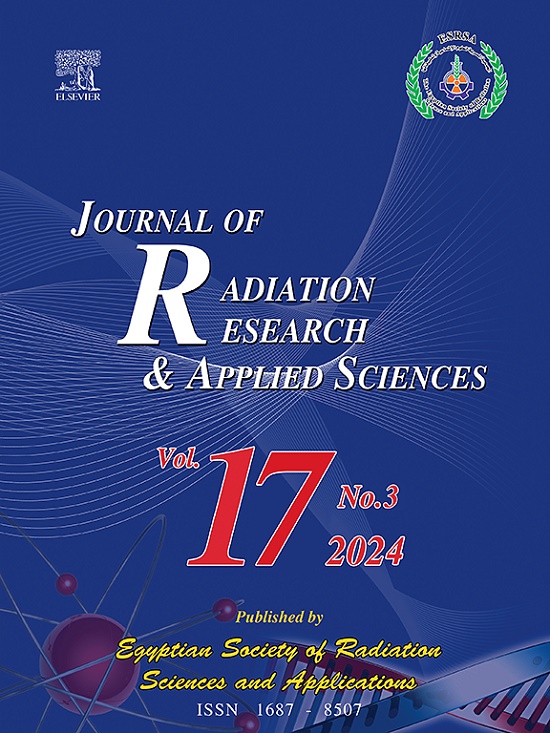Effect of small molecule phosphatidylinositol 3-kinase inhibitor combined with 5-fluorouracil on regulating progression of breast cancer cells
IF 1.7
4区 综合性期刊
Q2 MULTIDISCIPLINARY SCIENCES
Journal of Radiation Research and Applied Sciences
Pub Date : 2025-05-20
DOI:10.1016/j.jrras.2025.101624
引用次数: 0
Abstract
Objective
Recent studies confirmed that phosphatidylinositol 3-kinase (PI3K) pathway is involved in regulating progression of breast cancer (BC), suggesting its potential as a novel therapeutic target. This study aimed to investigate the mechanisms by which the small molecule PI3K inhibitor BKM120, combined with 5-fluorouracil (5-FU), suppresses the malignant biological behaviors of human BC (HBC) cells.
Methods
The HBC cells (MDA-MB-231) were randomized into four groups: Blank group (BG, regular culture), 5-FU group (10 μg/mL 5-FU treatment), BKM120 group (10 μmol/mL BKM120 treatment), and 5-FU + BKM120 group (combination treatment of 10 μg/mL 5-FU and 10 μmol/mL BKM120). Cell viability was assessed, while nuclear morphology was examined. The colony formation ability of cells was evaluated, and cell migration capacity was assessed. Flow cytometry was employed to analyze cell cycle (CC) changes, and western blotting determined expression levels of p-Akt, VEGF, and p53 protein.
Results
Relative to BG, both 5-FU and BKM120 groups demonstrated prominent reductions in cell viability, colony number, and wound healing rate. Additionally, nuclear fragmentation was observed, and G1 phase arrest occurred. The expression of p-Akt and VEGF proteins were greatly reduced, while p53 protein expression level was notably (p < 0.05) increased in the treated cells. Neglectable differences were observed between 5-FU and BKM120 groups. In comparison to 5-FU and BKM120 groups, the 5-FU + BKM120 group exhibited a further drastic decrease in cell viability, colony number, and wound healing rate, with exacerbated nuclear fragmentation and more pronounced G1 phase arrest. Furthermore, p-Akt and VEGF protein levels were further reduced, while p53 protein expression level was substantially (p < 0.05) increased.
Conclusion
The small molecule PI3K inhibitor BKM120, in combination with 5-FU, notably suppresses proliferation, colony formation, and migration of HBC cells. This mechanism is likely associated with G1 phase arrest, reduced levels of Akt phosphorylation, decreased VEGF expression level, and increased p53 expression level.
小分子磷脂酰肌醇3-激酶抑制剂联合5-氟尿嘧啶对乳腺癌细胞进展的调节作用
目的最近的研究证实,磷脂酰肌醇3-激酶(PI3K)通路参与调节乳腺癌(BC)的进展,提示其可能成为一种新的治疗靶点。本研究旨在探讨PI3K小分子抑制剂BKM120联合5-氟尿嘧啶(5-FU)抑制人BC (HBC)细胞恶性生物学行为的机制。方法将HBC细胞(MDA-MB-231)随机分为4组:空白组(BG,常规培养)、5-FU组(10 μmol/mL 5-FU处理)、BKM120组(10 μmol/mL BKM120处理)、5-FU + BKM120组(10 μmol/mL 5-FU和10 μmol/mL BKM120联合处理)。测定细胞活力,观察细胞核形态。评估细胞的集落形成能力,评估细胞的迁移能力。流式细胞术检测细胞周期(CC)变化,western blotting检测p-Akt、VEGF、p53蛋白表达水平。结果与BG相比,5-FU组和BKM120组的细胞活力、菌落数量和伤口愈合率均显著降低。此外,还观察到核碎裂,G1相阻滞。p- akt、VEGF蛋白表达量显著降低,p53蛋白表达量显著降低(p <;0.05)。5-FU组与BKM120组之间的差异可忽略不计。与5-FU和BKM120组相比,5-FU + BKM120组的细胞活力、菌落数量和伤口愈合率进一步急剧下降,细胞核碎裂加剧,G1期阻滞更明显。p- akt、VEGF蛋白表达水平进一步降低,p53蛋白表达水平显著降低(p <;0.05)增加。结论PI3K小分子抑制剂BKM120与5-FU联合可显著抑制HBC细胞的增殖、集落形成和迁移。这一机制可能与G1期阻滞、Akt磷酸化水平降低、VEGF表达水平降低和p53表达水平升高有关。
本文章由计算机程序翻译,如有差异,请以英文原文为准。
求助全文
约1分钟内获得全文
求助全文
来源期刊

Journal of Radiation Research and Applied Sciences
MULTIDISCIPLINARY SCIENCES-
自引率
5.90%
发文量
130
审稿时长
16 weeks
期刊介绍:
Journal of Radiation Research and Applied Sciences provides a high quality medium for the publication of substantial, original and scientific and technological papers on the development and applications of nuclear, radiation and isotopes in biology, medicine, drugs, biochemistry, microbiology, agriculture, entomology, food technology, chemistry, physics, solid states, engineering, environmental and applied sciences.
 求助内容:
求助内容: 应助结果提醒方式:
应助结果提醒方式:


